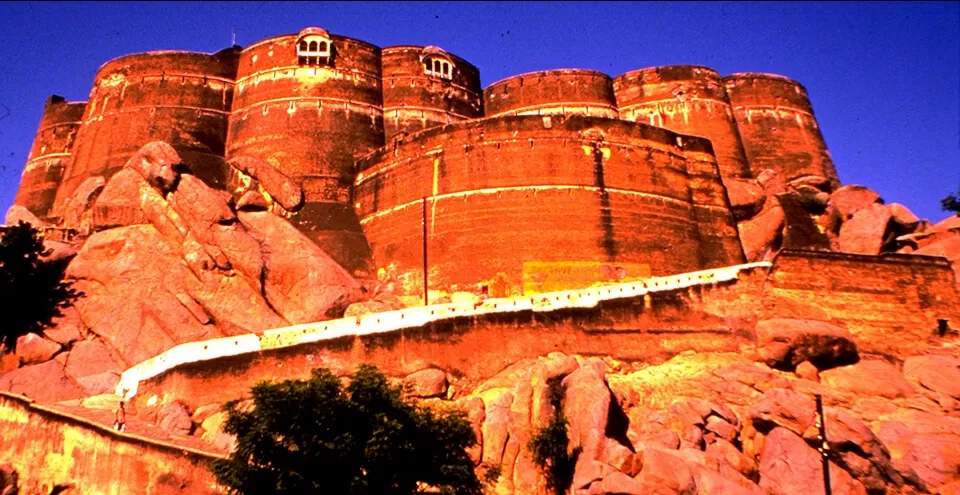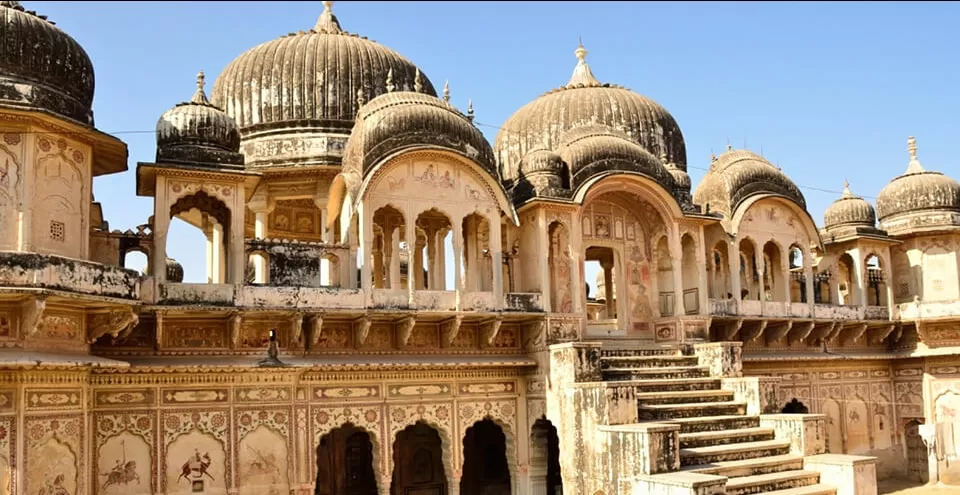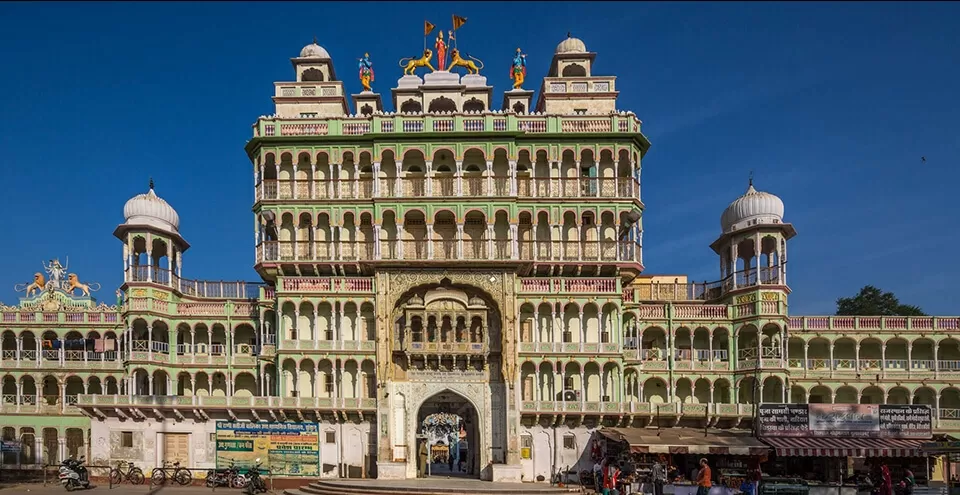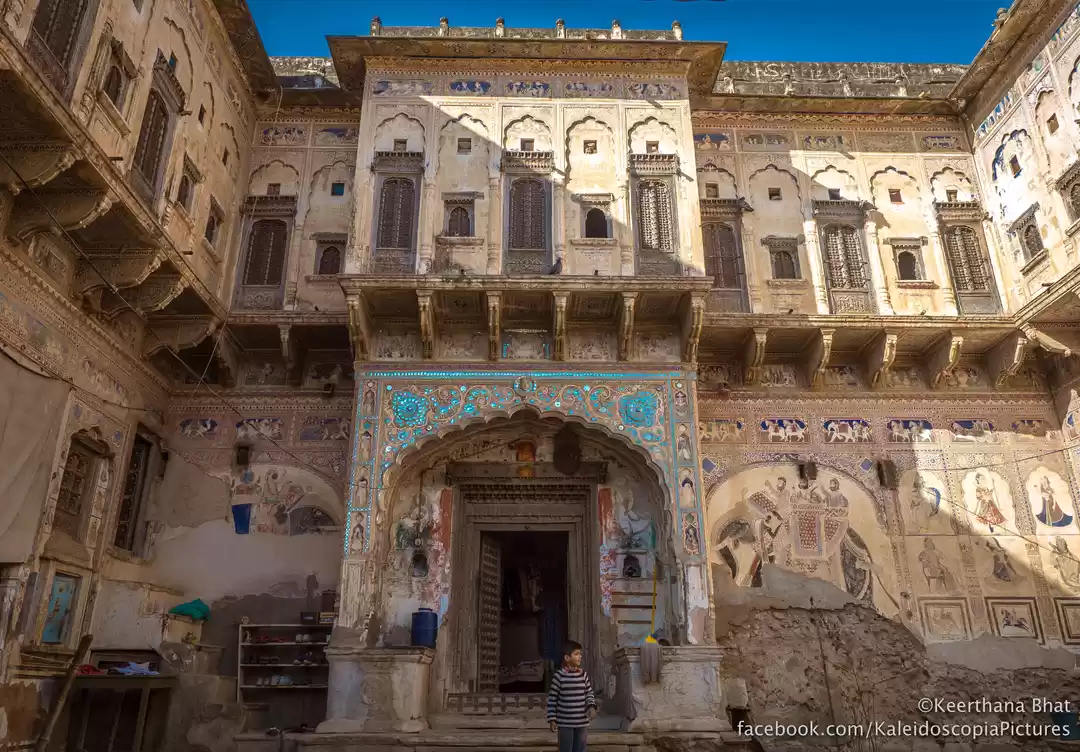















SHEKHAWATI CHURU, JHUNJHUNU & SIKAR The realm of lovely havelis, harking back to the yester years, epitomizes the beauty of Shekhawati – a region that comprises of Sikar, Jhunjhunu and Churu. It is a major landmark tourist destination of colourful Rajasthan. Once the bastion of Rao Shekha, this magnificent land, located on the North of Rajasthan, derives its nomenclature from the former. Shekhawati is a tourist's paradise. The land is laced with innumerable beautiful havelis or grand mansions that are guaranteed to capture one's imagination. It is a haven for a true connoisseur of art and architecture. A riot of colours encapsulates the spirit of this vibrant landscape. Exquisitely embellished havelis mushroomed during the eighteenth century and former half of the twentieth. Mythology and fauna lies at the very core of this wonderful art. Tales narrating the valour of Lord Rama and the miracles of Lord Krishna unfold on a journey of these marvellous mansions. The region also houses towering forts, baoris, and shrines, besides the ubiquitous havelis. ATTRACTIONS & PLACES TO VISIT AND EXPLORE IN SHEKHAWATI TAB 2ARROW TAB 1ARROW TAB 3ARROW Come explore the wonders and sites that Shekhawati has to offer you. There’s always something to see in Rajasthan. SETHANI KA JOHARA Sethani Ka Johara lies on the north side of the road perhaps 5 km west of Churu along the Ratangarh road. It is perhaps the finest johara (reservoir) in the area in that it is not only attractive but also efficient, holding a store of water, often from one monsoon to the next. It was built in 1899 by the widow of Bhagwan Das Bagla as part of the famine relief projects that the merchants financed in those terrible years of the close of the century. A peaceful place, it attracts various birds and animals, including Nilgais, in winter. KANHAIYALAL BAGLA HAVELI Kanhaiyalal Bagla Haveli is a beautiful structure, which stands on the south of the main bazaar. Constructed in around 1880, the haveli represents the finest lattice work and architectural styles in the entire Shekhawati region. The murals and wall paintings of the haveli depict Dhola and Maru, the romantic couple from folk tales, on a camel. The walls of the haveli are also adorned with the episodes of Dhola- Maru, the lovers fleeing on their camel. AATH KAMBH CHHATRI Aath Kambh Chhatri, one of the buildings possessing great historical significance, is an eight pillared dome that stands on the northern side of the town. Lying between the premises adjoining the western side of the vegetable market, the chhatri is believed to be constructed in 1776. Over the years, the windblown sand has virtually buried the base of the structure, while the interiors are still adorned with beautiful murals and stone carved paintings. RATANGARH FORT Located on the Agra-Bikaner Highway, the Ratangarh Fort was built in the early 18th century by Surat Singh, who named it after his son Ratan Singh, and boasts imposing gateways, several monuments (which are mostly in ruins today) and a clock tower, which is also known as Ghantaghar. The Ratangarh Fort makes for a lovely tourist destination, surrounded by several ethnic villages. LAXMINARAYAN TEMPLE Soothing to the eye, this temple is simple from the outside but has a grand architectural splendour from within. The entrance has a projected foliated arch adorned with beautiful mural paintings. It is easily accessible from all parts of Churu, and the serenity of this temple makes it a must-visit in your itinerary. DIGAMBAR JAIN TEMPLE The Jain Temple is a 150-year-old structure and can be described as piece of art in itself. Its interiors resemble a lavish royal court than a temple courtyard. This temple has some of the best paintings painted in gold, centred mostly on moral living suggestions. The walls and the interior are adorned with glass works characteristic of the magnificence of the Rajput era. TAL CHHAPAR SANCTUARY Renowned for being a safe haven black bucks and a variety of birds, this sanctuary is named after the Chhapar village. Located in the Sujangarh Tehsil of Churu, it is 210 km from Jaipur. Its open grasslands scattered with trees give it the appearance of a savannah. The sanctuary is a bird watcher’s paradise as it is home to birds such as eastern imperial eagle, black ibis, demoiselle cranes, skylarks, ring doves and more. One can also spot the desert fox and desert cat here. LAXMANGARH FORT Laxmangarh stands tall as the most impressive building in Laxmangarh town, looming majestically over the well laid township on its western side. An exceptional specimen of fort architecture in the entire world, Laxmangarh Fort is built upon scattered pieces of colossal rocks. The top of the ramp offers a fascinating bird's eye view of the Laxmangarh town modeled to resemble the city lay out of Jaipur – Rajasthan's bustling capital city. MANSA DEVI TEMPLE Mansa Devi Mandir is one of the holiest Hindu temples dedicated to Goddess Shakti. Mansa Devi, also known as Mata Rani and Vaishnavi, is a manifestation of the Mother Goddess. It is one of the most revered places of worship in Northern India. RAGHUNATHJI MANDIR Raghunathji Mandir, also known as Bara Mandir, is located in the vicinity of the Ratangarh town. Dedicated to Lord Raghunath or Rama, an incarnation of Lord Vishnu, the temple is believed to be constructed in early 19th century. It is a single storied temple with an elevated entrance. The top of the temple has a series of cupolas. The temple is believed to liberate one from the pains of life. FATEHPUR The city of Fatehpur was established by Kayamkhani Nawab Fateh Mohd in 1508 AD. He also constructed the Fort of Fatehpur in 1516. The city once served as the capital of Sikar. Today, Fatehpur is popularly known as the culture capital of Shekhawati. It is full of stunning sights to visit, of which, the Dwarkadheesh Mandir, Singhania Haveli, Nadine Le Prince Cultural Centre and Fatehchandka Haveli are the more notable ones. RAMGARH Ramgarh was founded in 1791 by the Poddar family, and back then, was considered one of the richest towns in 19th century India. Ramgarh is famous for its paintings, old temples, cenotaphs and havelis. While Ramgarh has a lot to offer in terms of sightseeing, the Ramgopal Chhatri (cenotaph) and Poddar’s Haveli are especially popular among tourists. KHETRI MAHAL Khetri Mahal in Khetri, Jhunjhunu is one of the most excellent instances of fine art and structural design of Shekhawati region. It is also known as the Wind Palace of Jhunjhunu. Khetri Mahal was built in the year 1770. A surprising factor is that Khetri Mahal has no windows or doors even though it is named as the Wind Palace. The inimitability of Khetri Mahal lies in the uninterrupted stream of wind which perpetually makes this construction unique from countless buildings. Almost all rooms of the Mahal are linked with each other through an ingenious chain of pillars and arches that offer a gorgeous proportioned vision to the fortress. SUNSET POINT MODA PAHAR Moda Pahar is popular spot for watching the sunset. With the beautiful Ajit Sagar Lake by its foot, this spot attracts many migratory birds and Barasinghas. The raw beauty of this spot makes it a favourite with the tourists. RANI SATI MANDIR Rani Sati Mandir is a well-known temple situated in Jhunjhunu district in the Rajasthan. This temple has a history of more than 400 years and is an indication to feminine bravery and spirit. It is also famous for its magnificence, and extraordinary paintings. It is also part of one of the oldest presented Indian pilgrimages. HAZRAT QAMRUDDIN SHAH'S DARGAH West of the Khetri Mahal, at the foot of the Nehara Pahar, lies the Dargah of Kamaruddin Shah. It is an atmospheric complex comprising a mosque and madrasa arranged around a pretty courtyard (still retaining some of its original murals), with the ornate dargah (tomb) of the Sufi saint Kamaruddin Shah in the centre. PANCHDEV MANDIR Shree Panchdev Temple is situated at the core of the well-known Shekhawati province. Every core of this province narrates its own history of bravery and valour. The excellent fresco paintings of havelis attracts a steady flow of tourists throughout the year. Shekhawati region offers many resorts of beauty, besides its religious and pilgrimage centres to the tourist. The architecture and design of the temple, along with the verdant garden around it makes it an aesthetically pleasing spot to visit. BANDE KA BALAJI TEMPLE It is a modern, single-storeyed temple with a surrounding shikhara and pinnacle. It is one of the most popular Hanuman temples in India. The idol of Balaji here is different from all other idols of Hanuman. Unlike other projections and idols of Hanuman, Balaji possess round face with moustache and beard making it the most unique idol among the other idols of Hanuman all over the world. MANDAWA Mandawa once functioned as a trading outpost for ancient caravan routes in Shekhawati for goods from China and the Middle East. Thakur Nawal Singh, then ruler of Nawalgarh and Mandawa built a fort in to protect this outpost. Over time, a township grew around the fort and soon attracted a large community of traders, who then settled down at Mandawa. The Mandawa fort, with its painted arched gateway is adorned with Lord Krishna and his cows. Built in accordance with a medieval theme, beautiful frescoes, exquisite carvings and mirror work add to its beauty. Situated in the middle of the town, the Mandawa Fort has now been converted into a heritage hotel. Mandawa is also famous for its beautiful havelis. DUNDLOD Dundlod, a town in Jhunjhunu is famous for its fort and havelis. This fort was built in 1750 by Keshari Singh, son of Rajput ruler, Sardul Singh. Dundlod is easily accessible by road from Delhi, Jaipur, and Bikaner. The Dundlod fort is a blend of the Rajput and Mughal art and architecture. The Chhatri (cenotaph) of Ram Dutt Goenka, located near the fort is also a popular tourist attraction. Built in 1888, the dome of the cenotaph is decorated with floral motifs with banners extending from the centre. The Marwari breed of horses, that are now finding their own identity across the world, are bred in Dundlod. ALSISAR Alsisar, a small town in Jhunjhunu is surrounded by arid dessert. Alsisar was awarded to Thakur Samarth Singh by his father, Thakur Pahad Singh of Heerwa, who made it his capital in 1783 AD. The famous Alsisar Mahal, a fine example of Rajput architecture with its fresco carvings and depiction of historical events on its walls, was built by Shekhawat Thikanedars. Alsisar is renowned for its Rajasthani hospitality, and tourists flock here to get a taste of that along with its famous castles, havelis and cenotaphs. Make sure you pay a visit to the Kejriwal Haveli, Laxmi Narayan temple, Thakur Chaatu Singh’s cenotaph, Ram Jas Jhunjhunwala Ki Haveli among others. BISSAU Bissau, a village in Jhunjhunu, was originally called Vishala Jat Ki Dhani. It was awarded to Thakur Keshri Singh by his Father MahaRao Shardul Singh Ji. Keshari Singh constructed a war fort and a defensive boundary wall for defence. He named it Bissau in 1746 AD. The rulers of Bissau belong to the Bhojraj clan of Shekhawats, and were the descendants of the famous ruler Maharao Shekha. NAWALGARH Located midway between Jhunjhunu and Sikar, Nawalgarh is well-known for its stunning havelis. It is also a favoured spot for film makers and many Indian and International movies have been shot here. A famous attraction here is the Nawalgarh Fort, which was built by Thakur Nawal Singh. The Roop Niwas Palace, located one km from Nawalgarh fort is a charming palace with beautiful gardens and fountains. It is now a heritage hotel. HOW TO REACH HERE The nearest Airport is Jaipur- 113 Kms There are direct buses from Delhi and other major cities of Rajasthan to Shekhawati. Regular trains are available from Delhi and Jaipur.


























